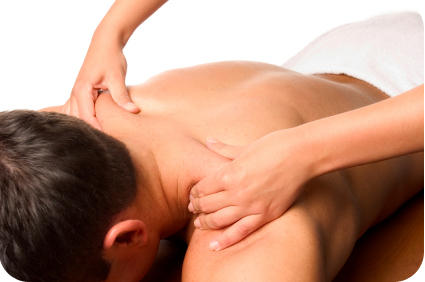Paleolithic Massage?
 Sunday, February 13, 2011 at 10:18PM
Sunday, February 13, 2011 at 10:18PM  Swedish massage. Image: istockphoto.comI am currently on a weekend break in the mountains but no longer snowboarding since my cycling injury. I had a massage yesterday, probably the fourth in my life. The experience led me to consider the origin of this practice. While the written record of massage dates to around 3000 BC, what about massage itself? Could its origin much older and date back to the late Paleolithic?
Swedish massage. Image: istockphoto.comI am currently on a weekend break in the mountains but no longer snowboarding since my cycling injury. I had a massage yesterday, probably the fourth in my life. The experience led me to consider the origin of this practice. While the written record of massage dates to around 3000 BC, what about massage itself? Could its origin much older and date back to the late Paleolithic?
My experience began at the “sanctuary”, a large dimly lit waiting area with a fireplace lending a cave-like atmosphere. The components of the massage (Swedish in this case) were music (specifically flute), oils, and human touch - each element available to humankind for millennia. In view of the millions of years of hominid grooming, it is reasonable to propose that this behavior became more structured with Homo sapiens, possibly at the time of Cro-Magnon, and led to massage or at least a massage-like practice. The flute is at least 40 thousand years old. Oil lamps were carried into the deep recesses of the Lascaux and Altamira caves by Cro-Magnon 13,000-18,000 years ago. Again, all the elements were there.
 Paleolithic flute. Image: José-Manuel Benito ÁlvarezDuring the massage it was easy to envision painted caves as the health spas of the past (Lascaux, Altamira?). However, the long hike in and out, at times turning into a crawl, certainly would not have been convenient. If massage did originate in the late Paleolithic, it was likely practiced during “down time”, maybe mid-afternoon or evening, as an extension of grooming.
Paleolithic flute. Image: José-Manuel Benito ÁlvarezDuring the massage it was easy to envision painted caves as the health spas of the past (Lascaux, Altamira?). However, the long hike in and out, at times turning into a crawl, certainly would not have been convenient. If massage did originate in the late Paleolithic, it was likely practiced during “down time”, maybe mid-afternoon or evening, as an extension of grooming.
Regardless of the actual origins of massage, human touch has been present for as long as humankind has existed. In modern times, the biology of touch and massage is being studied. In 2010, R. I. Dunbar reviewed the role of touch in social bonding:
Grooming is a widespread activity throughout the animal kingdom, but in primates (including humans) social grooming, or allo-grooming (the grooming of others), plays a particularly important role in social bonding.
I review the evidence for a neuropeptide basis for social bonding, and draw attention to the fact that the neuroendrocrine pathways involved are quite unresolved. Despite recent claims for the central importance of oxytocin, there is equally good, but invariably ignored, evidence for a role for endorphins.
In a recently published research trial, M.H. Rapaport, P. Schettler, and C. Bresee determined the biological effects of Swedish massage:
The purpose of this study was to determine effects of a single session of Swedish massage on neuroendocrine and immune function. It was hypothesized that Swedish Massage Therapy would increase oxytocin (OT) levels, which would lead to a decrease in hypothalamic-pituitary-adrenal (HPA) activity and enhanced immune function.
A single session of massage was compared to a light touch session. Blood levels of oxytocin (OT), “arginine-vasopressin (AVP), adrenal corticotropin hormone (ACTH), cortisol (CORT), circulating phenotypic lymphocytes markers, and mitogen-stimulated cytokine production” were measured. Healthy adults underwent “45 minutes of Swedish Massage Therapy versus a light touch control condition, using highly specified and identical protocols.” Those undergoing Swedish Massage Therapy had a:
- Large decrease in arginine-vasopressin (vasopressin lowers blood pressure among other functions)
- Small decrease in cortisol (the stress hormone)
- Increased circulating lymphocytes (immune cells)
- Decreased interleukin and IFN-gamma levels (immune response)
Although the decreases in arginine-vasopressin and cortisol were not mediated by oxytocin, massage was found to have favorable biological effects:
A single session of Swedish Massage Therapy produces measurable biologic effects. If replicated, these findings may have implications for managing inflammatory and autoimmune conditions.
So, if you are getting a massage, enjoy. It’s probably not the right time to think about the neurochemical and immune factors that are being affected, but it certainly is good for your mental and physical health.
 Massage in
Massage in  Rejuvenation
Rejuvenation 

Reader Comments